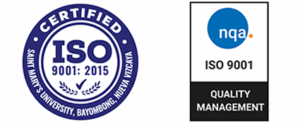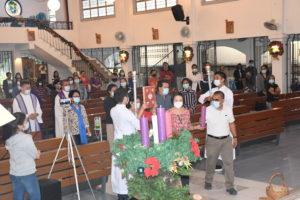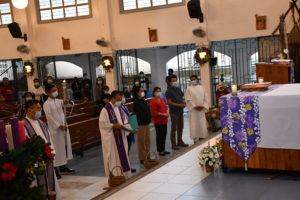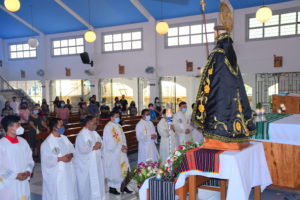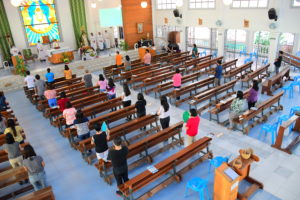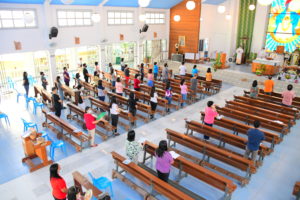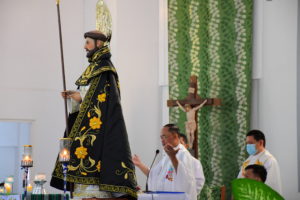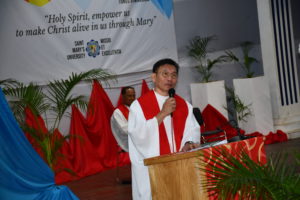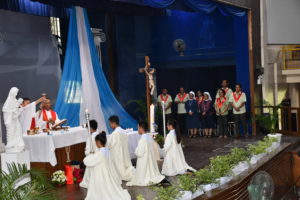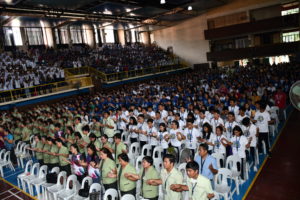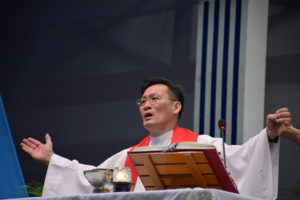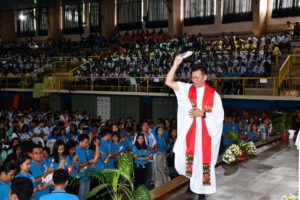CICM Pastoral Mission
CICM Pastoral Mission in Nueva Vizcaya: Historical Development, Transformation and Challenges
The Story Behind CICM Foundation and Expansion
The 19th century Europe was remarkable in myriad of things. Growths and expansions challenged the prevailing structure in different aspects. In politics, the parliament gained momentum and coexisted strongly with the monarchs. Scientific advancements became immense that provided revolutionary and liberal ideas. Industrialization paved the way for better and faster communication and transportation. Culture flourished and thrived even more than ever before. And the stature of the Catholic Church was altered.
In Belgium, some significant events could be related to the foundation of a new Catholic congregation, namely: political and religious condition; the scourges in the middle of the 19th century (diseases, drought and famine); and signs of showing the beginning of a missionary revival. For the political and religious situation, the disagreement over the meddling of the monarchs into the affairs of the Church continued. However, there was also a time when a peaceful political and religious atmosphere prospered. Particularly, in the years from 1831 – 1847 where no struggles among the leaders of the State and the Church had been recorded. Accordingly, this was due to the abandonment of the idea that leaders represent not what they want personally but for the well-being of their country as a whole (Pycke, 2009).
In 1862, the Congregatio Immaculati Cordis Marie (The Congregation of the Immaculate Conception of Mary) was founded by Father Theophile Verbist and some confreres in Scheut, a suburb of Belgium (MST Review, 2007). As time passed by, the CICM Congregation increased in number and so was the expansion of provincial mission stations in territories like China, Taiwan, Hongkong, Singapore, Indonesia, Japan and the Philippines. Other mission centers were established in Africa like Congo, Cameroon, Zambia, Senegal and Angola. In the Americas, countries such as Haiti, Guatemala, Brazil and Mexico and later in Europe such as Belgium, Netherlands, Italy, France and Germany became mission sites.
CICM in the Philippines
The CICM reached the Philippines in 1907. The decade was marked by political turmoil as the Filipino nation struggled for independence, first from the Spaniards and later, the Americans. Religious education came under the control of the American Protestants, using the English language as the medium of instruction (Verhelst & Pycke, 1995). With the victory of the Americans over Spain in the Battle of Manila Bay, the Spanish friars left the country and the church with the local clergy, mostly Aglipayans, who broke away from the Spanish friars some years back. Many parishes were left without priests. The period was also marked by the influx of protestant religious denominations which all the more divided the people (365 Days with the Lord, 2007).
In recognition of the plight of the Philippine church, Rome called upon missionary groups to save the imperiled church outpost in the Pacific. The CICM missionaries responded to this call through Bishop Dougherty. In November of 1907, Bishop Dougherty welcomed seven young missionary priests and a brother, with Superior Petrus Dietrickx. This group became the pioneer CICM confreres in the Philippines. This was followed by ten more missionaries in 1908 and in 1909, 13 more CICM priests were called to the evangelization mission. By April 2, 1909, the Philippines was then established as a religious province of the CICM (Verhelst & Pycke, 1995).
From Manila, the pioneer CICM confreres proceeded to the Northern Luzon where they had founded numerous institutions that endured the challenges of time even these current times. Verhelst and Pycke (1995) narrated that the group first settled in Baguio and started a hospital. As early in 1909, the provincial house “Home Sweet Home” was also constructed in this place. Thus, the next missionary stations were known to be the sub-provinces of Lepanto-Bontoc and Benguet.
CICM in Nueva Vizcaya
The third subprovince in the Northern Luzon entrusted to CICM was Nueva Vizcaya. Here, the churches and convents from the early Spanish missionaries – Augustinians and Dominicans, were handed over by the villagers who stayed firm in the Catholic faith despite adversaries and enticement from other religious denominations. The CICM had established their presence in the towns of Dupax, Bayombong and Solano in 1908, the town of Bambang in 1909, Bagabag in 1910 and Aritao in 1916 (Deprē, 1992).
The first CICM fathers in Nueva Vizcaya went through great challenges in various aspects. Deprē (1992) opined that upon the arrival of the pioneering confrères, they considered the place as totally impossible to start any efforts of evangelization because of, among others: lack of manpower; pessimistic view about the Spanish friars who had to leave the province due to the impact of the Philippine Revolution in the latter part of 1800s; dominance of the Aglipayan Church; and geographic location which was different from other provinces, a valley surrounded by mountains on all sides.
Notwithstanding, several factors were recorded to have aided the early missionaries in establishing their mission stations and winning the trust and confidence of the indigenous communities. One of which was a Supreme Court order providing that all the properties of the Roman Catholic Church should be returned to their legitimate owners such as the convents, churches, equipment and other ornaments (Deprē, 1992). Another was the admirable virtues, extended by the CICM priests that were shared by and reciprocated the values endeared by the Filipino people, such as the spirit of selflessness and self-sacrifice, patience, respect for all things, unconditional courteousness (Carrying on the mission, 2007).
Finally and perhaps the most enduring legacy of the CICM in the province were, and continues to be so, their zealous missionary spirit coupled with the establishment of educational institutions that ministered total human growth and development. Some of these are Saint Jerome Academy in Bagabag, Our Lady of Fatima High School in Villaverde, Saint Louis School in Solano, Saint Catherine in Bambang, Saint Terisita’s Academy in Aritao, Saint Mary’s High School in Dupax, and Saint Mary’s University in Bayombong.
CICM and Saint Mary’s University
The foundation of Saint Mary’s University could be traced back from the vision and initiative of Msgr. Constant Jurgens, CICM, who started the groundwork as early in 1918 when he was assigned as parish priest of Bayombong. However, this was interrupted when he was called in Netherlands to become the Director of the Bishop Hammer Institution (CICM Central Seminary). In 1928, Fr. Achilles de Gryse, CICM continued the vision of establishing an educational institution; thus, Saint Mary’s Elementary School was built, inaugurated and opened for enrolment of learners.
Fr. Godfrey Lambrecht, the parish priest of Bayombong from 1932 – 1954, opened Saint Mary’s High School in 1934. Then in 1947, Saint Mary’s College was established, given a permit to operate and offered programs such as Associate Arts (AA), Bachelor of Science in Education (BSE), Bachelor of Arts (AB) and Junior Normal (Nantes, Addauan, Aduca, Damayon, Del Rosario and Tayaban, 2015). From 1949 to 1952, the administration of Saint Mary’s College was continued by Rev. Fr. Gerard De Caestecker, CICM.
In 1955, the College of Engineering, under the leadership of Fr. Paul Zwanaepoel, CICM and through the academic and administrative supervision of Engr. Ruperto Bayabos, was opened and offered courses leading to the five-year Bachelor of Science in civil Engineering. The first four Civil Engineering graduates were presented in March 1960. Rev. Fr. Paul de Bevere, CICM succeeded Fr. Zwanaepoel from 1959-1962. Soon after, the Graduate School was also established with Master of Arts in Education, major in Guidance Counseling in 1962. In 1963, Fr. George Hantson, CICM became the school’s administrator and followed by Fr. Cornelio Tonus from 1963 to 1967.
The school continued to expand; thus, for better administration, its ownership and management was taken over by CICM in 1967 under Rev. Fr. Joseph van den Daelen, CICM, who became administrator from 1966 to 1968. Relative to the school’s expansion in 1967, the current campus site which is about 6.5 hectares near the Magat River, was acquired (Carrying on the Mission, 2007). The College Department moved to this newly acquired site in 1969 and so with the construction of the first academic building named in Honor of Rev. Fr. Godfrrey Lambrecht. Rev. Fr. John van Bauwel, CICM succeeded Fr. Joseph van den Daelen and became the President of Saint Mary’s College from 1968 to 1997.
Through the years, some more buildings and structures were built that provided learning spaces for learners. In 1975, Master of Arts in teaching programs catered to the professional growth of teachers in line with its designation as Regional Staff Development Center for Region 2 by the Educational Development Implementing Task Force (EDPITAF) and the Regional Science Teaching Center (RSTC). Accordingly, secondary biology, elementary mathematics, and elementary science were offered as majors. By 1977 social studies followed, with Filipino, English in 1978 and 1981 respectively and a little later that of secondary mathematics. Exploring the possibility of a post Graduate program, it was the first to open a doctorate program in educational management in 1979 (Nantes et al., 2015).
Many more departments were also opened which included the Schools of Arts and Sciences, Business, Education, Engineering and Architecture, Health Sciences, Public Administration & Governance, the Colleges of Accountancy and Law and additional courses in the graduate programs. In 1994, Saint Mary’s College was elevated to university status with Rev. Fr. Jan Van Bauwel, CICM as the first University President. In commemoration of this, the University Building was constructed, now named Constant Jurgens Building. Rev. Fr. Jessie M. Hechanova, CICM became the second University President in 1997 (Carrying on the Mission, 2007). With his leadership more edifices for different purposes were built such as the Resurrection Chapel, Jubilee Library Extension, High-School Administrative Bldg., Hantson Bldg., Sacred Heart Chapel and the Balay na Alumni.
As Saint Mary’s University continues its vision and missions, various levels of recognitions and marks of excellence were achieved. Some of these included accreditation for its programs by the Philippine Association of Schools, Colleges and Universities (PAASCU). It was also designated as a Center of Excellence for Teacher Education by the Commission on Higher Education (CHED) in 1996. Likewise in 2001, CHED granted SMU full autonomy, one of the 30 institutions which had this nationwide. And again, an autonomous status was regained from 2016 to 2019. SMU also was designated as Centers of Development in Civil Engineering in 2002 and IT Education in 2007. SMU graduates also continue to excel in various national licensure examinations and consistently getting high percentages of passers in board degree programs.
In 2005, Rev. Fr. Manuel D. Valencia, CICM, became the third University President and part of his tenure was the celebration of the CICM centenary in the Philippines. Some major accomplishments of his administration were the institution of SMU as the International Center for the Study of Teaching-Learning Styles, International Linkages, Ladderization Programs, Creation of the Center for Alternative and Continuing Education, Strengthening the research culture and the establishment of the Indigenous Knowledge and Tradition (IKAT) center (Nantes, et al., 2015).
The year 2010 transpired the installation of Rev. Fr. Renillo H. Sta. Ana, CICM as the fourth University President. His legacy could be summed up with themes of convergence and concordance and the revitalization of the core values of SMU such as excellence, innovation, communion and Christ’s mission. Fr. Renillo Sta. Ana strengthened and sustained the marks of mission and excellence, his achievements include, among others: the revision of the Administrative, Faculty and Staff Manual; Six-Year Development Plan; signing of the Collective Bargaining Agreement with SMU Employees’ Union; formulation of the new Vision-mission of SMU; construction of the Mary Seat of Wisdom Chapel, Patios Alois and Francois, Pedro Calungsod Hall, Pope John Paul II Building, Renato Sergeant Building and the like; implementation of a student-centered Shepherding Program; Level III PAASCU Accreditation of the Grade School, Teacher Education, Liberal Arts, Business, Engineering and Graduate Studies; and Level II PAASCU Accreditation of the High School Department.
On September 9, 2019, SMU entered into a new era at the installation of its fifth University President, Dr. John Octavious S. Palina. With him at the helm is a perpetuation of the school’s mantra, Inspired by Mission, Driven by Excellence. He underscored in his inaugural speech the need to maintain and sustain the virtues that made Saint Mary’s University into what it is now. He, however, articulated that SMU shall not be contented with all its accomplishments but these should be pushed further to achieve greater heights.
References:
365 Days with the Lord (2007). The CICM story in the Philippine setting. Centennial Edition. Makati: St. Pauls
Carrying on the mission: 100 years of CICM in the Philippines (2007). New Manila, Quezon City: CICM Philippines
Deprē, A., CICM (1992). From a tiny shoot. Manila: CICM
Nantes, F., Addauan, J., Aduca, E., Damayon, S., Del Rosario, F. and Tayaban, J. (2015). Saint Mary’s University @ 85: Passion for Mission and Tradition of Excellence. Faculty Research, Saint Mary’s University, Bayombong, Nueva Vizcaya.
Pycke, N. (2009). Théophile Verbist’s adventure. K.U. Leuven: Ferdinand Verbiest Institute
Verhelst, D. & Pycke, N. (1995). C.I.C.M. missionaries, past and present (1862 – 1987). Leuven, Belgium: Leuven University Press

